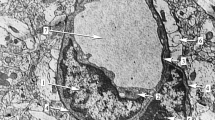Summary
Selected lobules of human term placentae were extracorporeally perfused for a recovery period of 20 min, fixed by perfusion and mordanted with ferrocyanide prior to processing for transmission electron microscopy. The lateral membranes of the endothelial cells of the terminal villous capillaries were found to be separated by paracellular clefts of mean width 15.6 nm. At tight junctional regions (1–4 sites per cleft) the two membranes approached each other more closely and frequently appeared to fuse. However, tilting of the sections in the electron microscope stage showed that the membranes were separated by a gap of mean width 4.1 nm in at least 94% of tight junctional profiles. When individual tight junctions were studied by a combination of serial sectioning and goniometric tilting, they were seen to widen abruptly within a distance of three to seven consecutive thin sections, indicating they were not continuous throughout the axial length of the capillaries. The wide regions of the clefts usually showed linkers, strands of glycocalyx-like material spanning the gap. Linkers may contribute to cell adhesion and possibly form part of a filter within the tortuous paracellular pathway provided by the discontinuous network of tight junctional strands. Human term placental capillaries appear to resemble closely other continuous non-brain capillaries.
Similar content being viewed by others
References
Adamson RH, Michel CC (1991) The ultrastructure of pathways through the intercellular clefts of frog mesenteric capillaries. J Physiol 435:26
Bundgaard M (1980) Transport pathways in capillaries — in search of pores. Ann Rev Physiol 42:325–336
Bundgaard M (1984) The three dimensional organisation of tight junctions in a capillary endothelium revealed by serial-section electron microscopy. J Ultrastruct Res 88:1–17
Contractor SF, Stannard PJ (1983) The use of AIB transport to assess the suitability of a system of human perfusion for drug transport studies. Placenta 4:19–30
Crone C, Levitt DG (1984) The exchange of small solute through the capillary wall. In: Renkin EM, Michel CC (eds) Handbook of physiology. The cardiovascular system, vol IV: The microcirculation. American Physiology Society, Bethesda, pp 411–466
Firth JA, Bauman K, Sibley C (1983) The intercellular junctions of guineapig placental capillaries: a possible structural basis for endothelial solute permeability. J Ultrastruct Res 85:45–57
Heinrich D, Metz E, Raviola E, Forssmann WG (1976) Ultrastructure of perfusion-fixed fetal capillaries in the human placenta. Cell Tissue Res 172:157–169
Karnovsky MJ (1965) A formaldehyde-glutaraldehyde fixative of high osmolality for use in electron microscopy. J Cell Biol 27:137 A
Karnovsky M (1967) The ultrastructural basis of capillary permeability studied with peroxidase as a tracer. J Cell Biol 35:213–236
Kaufmann P (1985) Influence of ischemia and artificial perfusion on placental ultrastructure and morphometry. Contrib Gynecol Obstet 13:18–26
Kaufmann P, Sen DK, Schweikhart G (1979) Classification of human placental villi. 1. Histology. Cell Tissue Res 200:409–423
Michel CC (1980) Filtration coefficients and osmotic reflection coefficients of the walls of single frog mesenteric capillaries. J Physiol 309:341–355
Miller RK, Wier PJ, Maulik D, di Sant'agnese PA (1985) Human placenta in vitro: characterization during 12 hr of dual perfusion. Contrib Gynecol Obstet 13:77–84
Palade GE, Simionescu M, Simionescu N (1979) Structural aspects of the permeability of the microvascular endothelium. Acta Physiol Scand [Suppl] 463:11–32
Panigel M (1968) Placental perfusion. In: Wynn R (ed) Fetal homeostasis. Appleton Century Crofts, New York, pp 15–25
Pappenheimer JR, Renkin JR, Borrero LM (1951) Filtration, diffusion and molecular sieving through peripheral capillary membranes. A contribution to the pore theory of capillary permeability. Am J Physiol 167:13–46
Reese TS, Karnovsky MJ (1967) Fine structural localization of a blood-brain barrier to exogenous peroxidase. J Cell Biol 34:207–217
Schulze C, Firth JA (1992) The interendothelial junction in myocardial capillaries: evidence for the existence of regularly spaced, cleft-spanning structures. J Cell Sci (in press)
Sideri M, Zannoni E, Challier J-C (1987) Transfer of horseradish peroxidase across the human placental cotyledon perfused in vitro. Trophoblast Res 2:573–584
Silberberg A (1988) Structure of the interendothelial cell cleft. Biorheology 25:303–318
Simionescu N, Simionescu M, Palade G (1973) Permeability of muscle capillaries to exogenous myoglobin. J Cell Biol 57:424–452
Ward BJ, Firth JA (1989) Effect of hypoxia on endothelial morphology and interendothelial junctions in the isolated perfused rat heart. J Mol Cell Cardiol 21:1337–1347
Ward BJ, Bauman KF, Firth JA (1988) Interendothelial junctions of cardiac capillaries in rats: their structure and permeability properties. Cell Tissue Res 252:57–66
Wissig SL (1979) Identification of the small pore in muscle capillaries. Acta Physiol Scand [Suppl] 463:33–44
Author information
Authors and Affiliations
Rights and permissions
About this article
Cite this article
Leach, L., Firth, J.A. Fine structure of the paracellular junctions of terminal villous capillaries in the perfused human placeta. Cell Tissue Res 268, 447–452 (1992). https://doi.org/10.1007/BF00319151
Received:
Accepted:
Issue Date:
DOI: https://doi.org/10.1007/BF00319151




